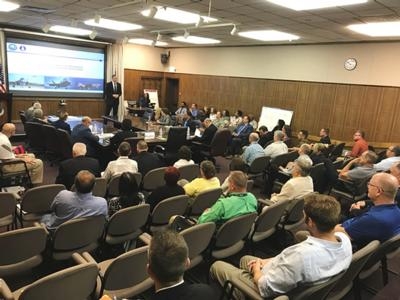Navy Team Travels To Air Force Sustainment Center For Full Week Of Discussions
With the greatest fighter aircraft of modern times comes enormous responsibility. A team from the F-35 Integrated Weapon Systems Team (IWST) at Naval Supply Systems Command Weapon Systems Support (NAVSUP WSS) recently made a trip to Hill Air Force Base in Utah, July 16-20, to map out a course for F-35 future sustainment and supply chain management.

Hosted by the Air Force Sustainment Center, subject matter expert participants for the F-35 Provisioning Mapping Event included the Office of the Secretary of Defense (OSD), Departments of the Navy and Air Force, F-35 Joint Program Office (JPO) and Defense Logistics Agency (DLA), covering supply chain management (SCM) areas of finance, provisioning, contracting, engineering and logistics reassignment. The Boston Consulting Group facilitated the mapping event – a follow-on provisioning conference – for an organic SCM option to sustain the F-35 in the near future. The first meeting was a pre-provisioning conference hosted by NAVSUP in April 2018, where specific provisioning technical data was provided to the JPO to incorporate into contract data requirements lists.
The U.S. Marine Corps’ deployment of 16 F-35B Lightning II Joint Strike Fighters (the Short Takeoff and Vertical Landing (STOVL) variant) to Japan with Marine Fighter Attack Squadron 121 came under scrutiny in early 2017 when issues regarding “lengthy travel times for parts, inaccurate estimated delivery dates and delays at customs and difficulty shipping Autonomic Logistics Information System (ALIS) equipment,” surfaced from a Government Accountability Office(GAO) report in April.
According to a separate GAO report, the F-35 fighter jet is the defense department’s largest and most expensive weapons program, with a projected life-cycle cost of more than $1 trillion over a 60-year lifecycle span.
“In order to effectively integrate and sustain the F-35 in the joint force, the military departments must have more direct ownership of the F-35 program and leverage organic capabilities, processes and infrastructure,” said Ellen Lord, Undersecretary of Defense for Acquisitions and Sustainment wrote in a letter to Congress in March 2018 in response to the GAO reports and to the seemingly insurmountable sustainment costs.
Lord and other OSD leadership, like Robert McMahon, Assistant Secretary of Defense for Logistics Materiel and Readiness, directed DLA to start accelerating the cataloging of the F-35 to explore the option of organic supply support. According to Jack Courtney, F-35 IWST lead at NAVSUP WSS, there was already a body of research to draw information.
“There was a concerted effort about five years ago called the organic supply chain working group that went on for months,” said Courtney. “I think that now there is greater emphasis on this recent effort for programs like the F-35, and the work we did at the mapping event leveraged all of that great work and research that was done previously to look into an organic solution.”

According to Lord, lethality and readiness drive acquisition and sustainment reform. “We need to start thinking about sustainment more when we design systems, so that we are designing [them] to be maintainable,” she explained. “To be able to change out parts quickly, we need to make sure that we think about the costs of sustaining systems.” Lord added that 70 cents of every dollar DoD spends over the lifecycle of a program goes to sustainment.
Will Roper, U.S. Air Force assistant secretary for acquisition, technology and logistics, mentioned that a lot of the sustainment challenges can be solved through software modernization. “Supply chain management happens via software,” said Roper, who intends to drive down the F-35’s sustainment costs. “Predictive maintenance could significantly drive down sustainment costs, especially if the department utilizes new technologies that help it pinpoint exactly when maintenance should be done on the jet.”
The mapping event, although not focused on maintenance just yet, is a result of the services and JPO’s preliminary efforts to collaborate on materiel provisioning for future F-35 sustainment. As the Navy’s only Program Support Inventory Control Point (PSICP), NAVSUP WSS naturally took great interest in the mapping event and how to best support the total program lifecycle for end-to-end support of the F-35.
After OSD tasked DLA to accelerate the F-35 cataloging effort, and after the NAVSUP-hosted pre-provisioning conference, NAVSUP WSS pulled together to do some “homework” before heading out to Utah for the Provisioning Mapping Event. The “homework” included reading over the all the data gathered from previous working groups and looking over lessons learned from other programs’ transition records.
After a week of discussions, breakout sessions, and working group meetings, the team provided a framework for establishing an executable organic supply chain management option with a Material Support Date (MSD), potential courses of action and conditions for each, and a summary of transition tasks, risks, roles and responsibilities.
According to Lt. Cmdr. Danny Ewing, NAVSUP WSS F-35 IWST, the working group – formed as a result of this mapping event – is using a phased approach to achieve its milestones.
Those milestones include establishing and validating a DLA managed set of common consumables, so long as the customers’ demand data is made available for accurate requirements forecasting. Another quick win would be exercising the flexibility of the Working Capital Fund to support a more continuous logistics support execution.
“Overall, I think the mapping event was very positive,” Courtney concluded. “The group dynamics were very productive with excellent collaboration with the Air Force and DLA, and I think we have made some substantial headway in looking at an organic program support option.”
(Source: U.S. Navy news release. Images provided)
 Airborne 04.16.24: RV Update, Affordable Flying Expo, Diamond Lil
Airborne 04.16.24: RV Update, Affordable Flying Expo, Diamond Lil ANN's Daily Aero-Term (04.20.24): Light Gun
ANN's Daily Aero-Term (04.20.24): Light Gun Aero-News: Quote of the Day (04.20.24)
Aero-News: Quote of the Day (04.20.24) Aero-News: Quote of the Day (04.21.24)
Aero-News: Quote of the Day (04.21.24) ANN's Daily Aero-Term (04.21.24): Aircraft Conflict
ANN's Daily Aero-Term (04.21.24): Aircraft Conflict




